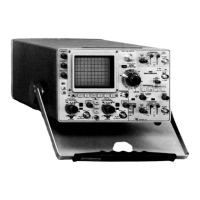Maintenance—485/R485 Service
of pliers. Be careful not to damage the wiring on the board
with too much heat. Ream out the hole in the circuit board
with a 0.031-inch drill. Remove the ferrule from the new
interconnecting pin and press the new pin into the hole in
the circuit board. Position the pin in the same manner as
the old pin. Then, solder the pin on both sides of the circuit
board. If the old pin was bent at an angle to mate with a
connector, bend the new pin to match the associated pins.
B. CIRCUIT BOARD PIN SOCKETS.
The pin sockets on the circuit boards are soldered to the
rear of the board. To replace one of these sockets, first
unsolder the pin (use a vacuum-type desoldering tool to
remove excess solder). Then, straighten the tabs on the
socket and remove it from the hole in the circuit board.
Place the new socket in the circuit-board hole and press the
tabs down against the board. Solder the tabs of the socket
to the circuit board; be careful not to get solder into the
socket.
NOTE
The spring tension o f the pin sockets ensures a good
connection between the circuit board and the pin.
This spring tension can be destroyed by using the pin
sockets as a connecting point for spring-loaded probe
tips, alligator dips, etc.
C. END-LEAD PIN CONNECTORS.
The pin connectors used to connect the wires to the
interconnecting pins are clamped to the ends of the
associated leads. To replace damaged end-lead pin con
nectors, remove the old pin connector from the end of the
lead and clamp the replacement connector to the lead.
Some of the pin connectors are grouped together and
mounted in a plastic holder; the overall result is that these
connectors are removed and installed as a multi-pin
connector. To provide correct orientation of this multi-pin
connector when it is replaced, an arrow is stamped on the
circuit board or chassis and a matching arrow is molded
into the plastic housing of the multi-pin connector. Be sure
these arrows are aligned as the multi-pin connector is
replaced. If the individual end-lead pin connectors are
removed from the plastic holder, note the color of the
individual wires for replacement.
Cathode-Ray Tube Replacement. To replace the
cathode-ray tube, proceed as follows:
WARNING
remains on the Post Accelerating Anode lead after the
instrument has been turned off. When disconnecting
the Post Accelerating lead pu ll it out in a manner that
it w ill touch and discharge to the chassis ground
immediately after clearing the housing (take care to
avoid discharge to the nearby vertical deflection
connections). This procedure must be repeated every
time the Post Accelerating lead is removed. I f it is
connected and removed without the instrument being
turned on, it will have accepted a charge from the
Anode M ultiplier and will again be dangerous when
disconnected.
1. Disconnect Post Accelerating lead.
2. Disconnect the 6 CRT deflection plate leads.
3. Remove rear panel for access to CRT base.
4. Remove CRT base connector.
5. Remove four screws from CRT bezel and remove
bezel from the front of the instrument.
6. Push CRT carefully out the front of the instrument.
REPACKAGING FOR SHIPMENT
If the Tektronix instrument is to be shipped to a Tektronix
Service Center for service or repair, attach a tag showing:
owner (with address) and the name of an individual at your
firm that can be contacted, complete instrument serial
number and a description of the service required.
Save and re-use the package in which your instrument was
shipped. If the original packaging is unfit for use or not
available, repackage the instrument as follows:
1. Obtain a carton of corrugated cardboard having inside
dimensions of no less than six inches more than the
instrument dimensions; this will allow for cushioning.
Refer to the following table for carton test strength
requirements.
2. Surround the instrument with polyethylene sheeting to
protect the finish of the instrument.
3. Cushion the instrument on all sides by tightly packing
dunnage or urethane foam between carton and instru
ment, allowing three inches on all sides.
4. Seal carton with shipping tape or industrial stapler.
SHIPPING CARTON TEST STRENGTH
Use care when handling a CRT. Protective clothing
and safety glasses should be worn. Avoid striking it
on any object which might cause it to crack or
implode. When storing a CRT, place it in a protective
carton or set it face down in a protected location on a
smooth surface with a soft mat under the faceplate to
protect it from scratches. A high voltage charge
Gross Weight (lb)
Carton Test St
0-10
200
10-30
275
30-120
375
120-140
500
140-160
600
Rev. B, MAR. 1976
4-15

